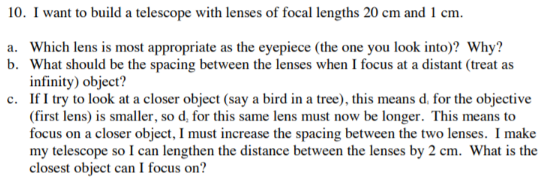10. I want to build a telescope with lenses of focal lengths 20 cm and 1 cm. a. Which lens is most appropriate as the eyepiece (the one you look into)? Why? b. What should be the spacing between the lenses when I focus at a distant (treat as infinity) object? c. If I try to look at a closer object (say a bird in a tree), this means d. for the objective (first lens) is smaller, so d, for this same lens must now be longer. This means to focus on a closer object, I must increase the spacing between the two lenses. I make my telescope so I can lengthen the distance between the lenses by 2 cm. What is the closest object can I focus on?
10. I want to build a telescope with lenses of focal lengths 20 cm and 1 cm. a. Which lens is most appropriate as the eyepiece (the one you look into)? Why? b. What should be the spacing between the lenses when I focus at a distant (treat as infinity) object? c. If I try to look at a closer object (say a bird in a tree), this means d. for the objective (first lens) is smaller, so d, for this same lens must now be longer. This means to focus on a closer object, I must increase the spacing between the two lenses. I make my telescope so I can lengthen the distance between the lenses by 2 cm. What is the closest object can I focus on?
Physics for Scientists and Engineers, Technology Update (No access codes included)
9th Edition
ISBN:9781305116399
Author:Raymond A. Serway, John W. Jewett
Publisher:Raymond A. Serway, John W. Jewett
Chapter38: Diffraction Patterns And Polarization
Section: Chapter Questions
Problem 38.8OQ: Why is it advantageous to use a large-diameter objective lens in a telescoped (a) It diffracts the...
Related questions
Question

Transcribed Image Text:10. I want to build a telescope with lenses of focal lengths 20 cm and 1 cm.
a. Which lens is most appropriate as the eyepiece (the one you look into)? Why?
b. What should be the spacing between the lenses when I focus at a distant (treat as
infinity) object?
c. If I try to look at a closer object (say a bird in a tree), this means d. for the objective
(first lens) is smaller, so d, for this same lens must now be longer. This means to
focus on a closer object, I must increase the spacing between the two lenses. I make
my telescope so I can lengthen the distance between the lenses by 2 cm. What is the
closest object can I focus on?
Expert Solution
This question has been solved!
Explore an expertly crafted, step-by-step solution for a thorough understanding of key concepts.
This is a popular solution!
Trending now
This is a popular solution!
Step by step
Solved in 5 steps with 4 images

Recommended textbooks for you

Physics for Scientists and Engineers, Technology …
Physics
ISBN:
9781305116399
Author:
Raymond A. Serway, John W. Jewett
Publisher:
Cengage Learning

College Physics
Physics
ISBN:
9781305952300
Author:
Raymond A. Serway, Chris Vuille
Publisher:
Cengage Learning

Principles of Physics: A Calculus-Based Text
Physics
ISBN:
9781133104261
Author:
Raymond A. Serway, John W. Jewett
Publisher:
Cengage Learning

Physics for Scientists and Engineers, Technology …
Physics
ISBN:
9781305116399
Author:
Raymond A. Serway, John W. Jewett
Publisher:
Cengage Learning

College Physics
Physics
ISBN:
9781305952300
Author:
Raymond A. Serway, Chris Vuille
Publisher:
Cengage Learning

Principles of Physics: A Calculus-Based Text
Physics
ISBN:
9781133104261
Author:
Raymond A. Serway, John W. Jewett
Publisher:
Cengage Learning

Physics for Scientists and Engineers
Physics
ISBN:
9781337553278
Author:
Raymond A. Serway, John W. Jewett
Publisher:
Cengage Learning

Physics for Scientists and Engineers with Modern …
Physics
ISBN:
9781337553292
Author:
Raymond A. Serway, John W. Jewett
Publisher:
Cengage Learning

College Physics
Physics
ISBN:
9781285737027
Author:
Raymond A. Serway, Chris Vuille
Publisher:
Cengage Learning